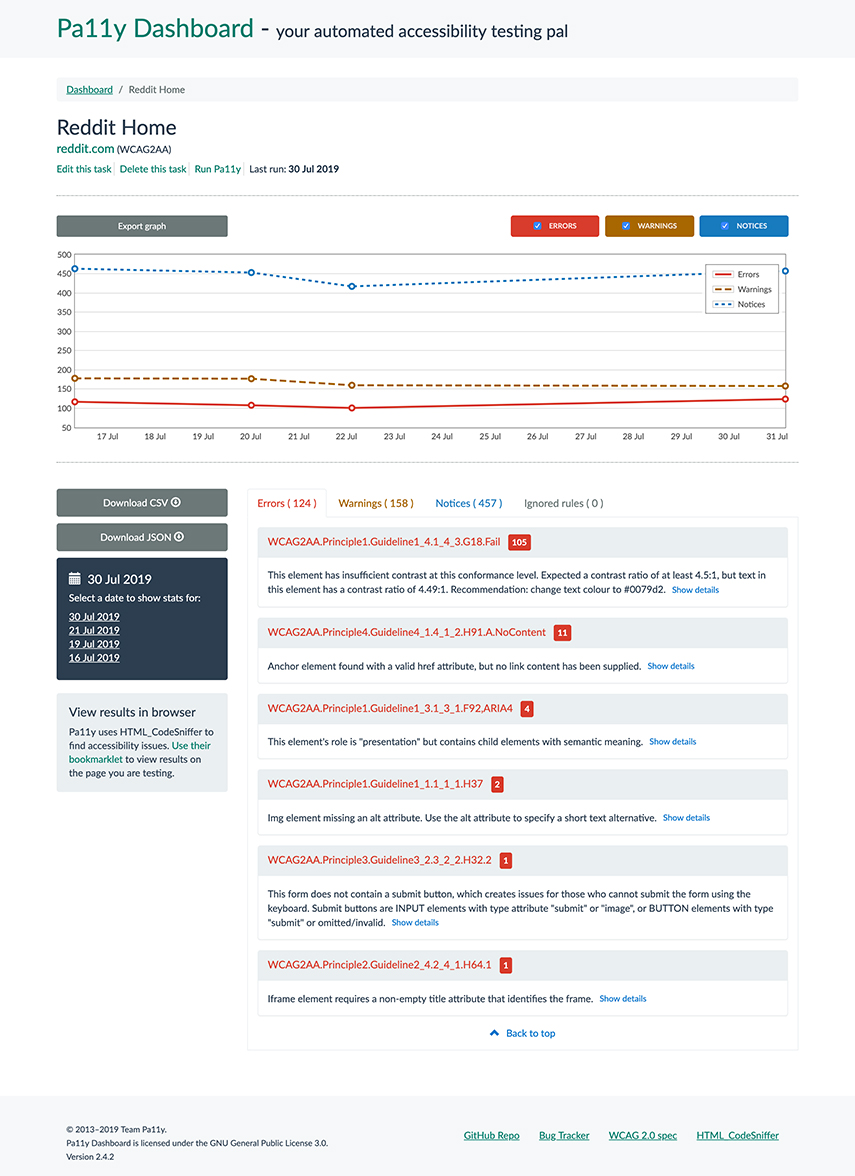Pa11y Dashboard is a web interface to the Pa11y accessibility reporter; allowing you to focus on fixing issues rather than hunting them down.
Pa11y Dashboard is a Node.js application and requires a stable or LTS version of Node, currently version 8 or greater.
Pa11y Dashboard also requires a MongoDB database to be available so it can store the results of the tests. The database doesn't have to be in the same server or computer where Pa11y Dashboard is running from.
Since version 3, Pa11y Dashboard uses Headless Chrome in order to run the tests. This means that additional dependencies maybe be required.
In Unix-like systems you may need to install the libnss3 and libgconf-2-4 libraries in order to be able to run Chrome. If you're trying to run the app in a headless environment (e.g. the cloud, or a headless server), you may also need to configure Xvfb before. Please refer to the documentation from your provider for details on how to do this.
In order to run Pa11y Dashboard, we recommend cloning this repository locally:
git clone https://github.com/pa11y/pa11y-dashboard.gitThen installing the dependencies:
cd pa11y-dashboard
npm installYou'll also need to have MongoDB installed and running. For quick access, you can install via a package manager such as on Mac OS brew install mongodb or on Linux (Debian) it would be apt-get install mongodb. To run MongoDB, you can run mongod in the command line. See the MongoDB install guide for more detailed information.
The last step before being able to run the application is to define a configuration for it. This can be done in two ways:
Each configuration can be set with an environment variable rather than a config file. For example to run the application on port 8080 you can use the following:
PORT=8080 node index.jsThe available configurations are documented here.
You'll need to copy and modify different config files depending on your environment (set with NODE_ENV):
cp config/development.sample.json config/development.json
cp config/production.sample.json config/production.json
cp config/test.sample.json config/test.jsonEach of these files defines configurations for a different environment. If you're just running the application locally, then you should be OK with just development and test configurations. The available configurations are documented here.
Now that you've got your application configured, make sure you have a MongoDB server running with the mongod command in another terminal window. You can run in each mode by changing the NODE_ENV environment variable:
NODE_ENV=development node index.jsSee Contributing for more information about running locally (and restarting automatically when files change).
If you run into problems, check the troubleshooting guide.
The boot configurations for Pa11y Dashboard are as follows. Look at the sample JSON files in the repo for example usage.
(number) The port to run the application on. Set via a config file or the PORT environment variable.
(boolean) If set to true (default), the dashboard will not be indexed by search engines. Set to false to allow indexing. Set via a config file or the NOINDEX environment variable.
(boolean) If set to true, users will not be able to add, delete or run URLs (defaults to false). Set via a config file or the READONLY environment variable.
(string) A message to display prominently on the site home page. Defaults to null.
This can either be an object containing Pa11y Webservice configurations, or a string which is the base URL of a [Pa11y Webservice][pa11y-webservice] instance you are running separately. If using environment variables, prefix the webservice vars with WEBSERVICE_.
There are many ways to contribute to Pa11y Dashboard, we cover these in the contributing guide for this repo.
If you're ready to contribute some code, you'll need to clone the repo and get set up as outlined in the setup guide. You'll then need to start the application in test mode with:
NODE_ENV=test node index.jsYou'll now be able to run the following commands:
make verify # Verify all of the code (ESLint)
make test # Run all tests
make test-integration # Run the integration testsTo compile the client-side JavaScript and CSS, you'll need the following commands. Compiled code is committed to the repository.
make less # Compile the site CSS from LESS files
make uglify # Compile and uglify the client-side JavaScript- Setting up An Accessibility Dashboard from Scratch with Pa11y on DigitalOcean
- Monitoring Web Accessibility Compliance With Pa11y Dashboard
Pa11y Dashboard major versions are normally supported for 6 months after their last minor release. This means that patch-level changes will be added and bugs will be fixed. The table below outlines the end-of-support dates for major versions, and the last minor release for that version.
We also maintain a migration guide to help you migrate.
| ❔ | Major Version | Last Minor Release | Node.js Versions | Support End Date |
|---|---|---|---|---|
| ❤️ | 3 | N/A | 8+ | N/A |
| ⌛ | 2 | 2.4.2 | 4+ | 2020-01-16 |
| 💀 | 1 | 1.12 | 0.10–6 | 2016-12-05 |
If you're opening issues related to these, please mention the version that the issue relates to.
Pa11y Dashboard is licensed under the GNU General Public License 3.0.
Copyright © 2013–2019, Team Pa11y and contributors





